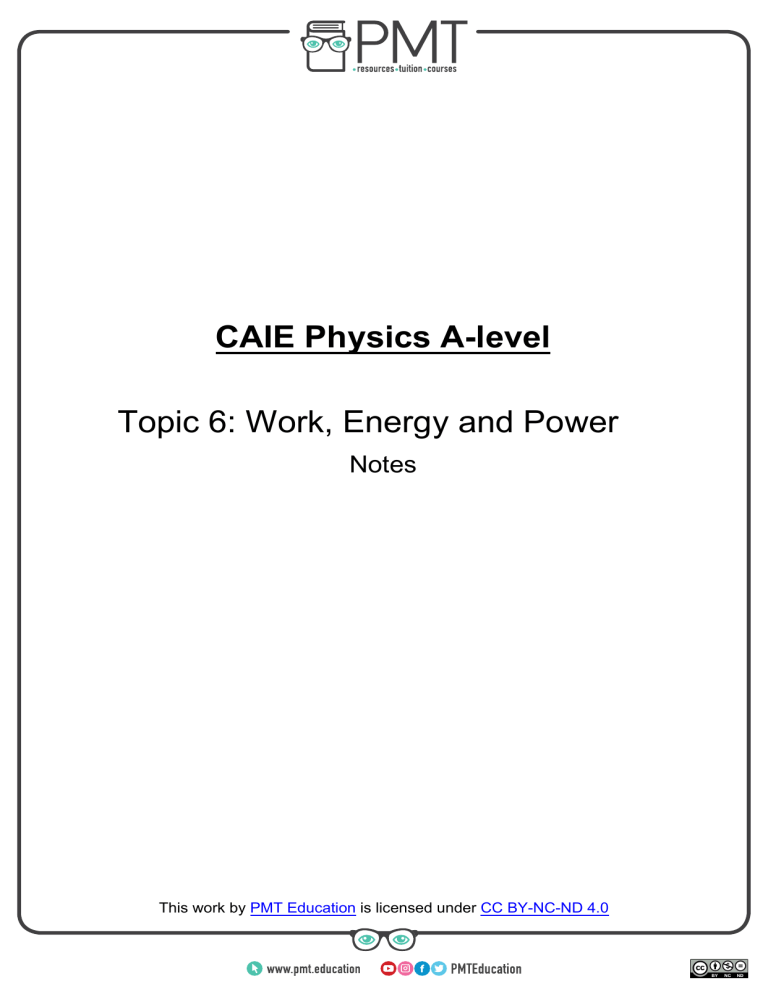
CAIE Physics A-level Topic 6: Work, Energy and Power Notes https://bit.ly/pmt-edu-cc This work by PMT Education is licensed under https://bit.ly/pmt-cc CC BY-NC-ND 4.0 https://bit.ly/pmt-edu https://bit.ly/pmt-cc https://bit.ly/pmt-cc 6 - Work, Energy and Power 6.1 - Energy Conversion and Conservation The principle of conservation of energy states that energy cannot be created or destroyed, but can be transferred from one form to another. Therefore, the total energy in a closed system stays constant. T otal energy in = T otal energy out Energy is defined as the capacity to do work and comes in different forms: ➔ Gravitational potential energy - this is dependent on the object’s position in a gravitational field and its mass. It increases as an object’s height above the ground increases. ➔ Kinetic energy - this is the energy stored by an object when it is moving and is dependent on the object’s mass and velocity. ➔ Internal energy - this is equal to the sum of all of the kinetic energies and potential energies of all the particles of an object. ➔ Elastic potential energy - this is the energy stored by an object when it is squashed or stretched. ➔ Electrical potential energy - this is dependent on a charged object's position in an electric field. Energy is transferred from one form to another when: ● Work is done - for example, when an object is squashed, kinetic energy is converted into elastic potential energy. ● Energy is emitted or absorbed in the form of electromagnetic radiation - for example, when thermal/internal energy of a radiator is transmitted by infrared radiation. As another example, think about a ball being thrown up into the air. The thrower gives the ball kinetic energy therefore it moves upwards, however as it does, the ball slows down because kinetic energy is transferred to gravitational potential energy. Eventually, all of the kinetic energy is transferred to gravitational potential energy and the ball stops momentarily, after which the ball’s gravitational potential energy is converted back into kinetic energy and the ball falls to the ground. It is very important to note that work is being done by the ball to work against resistive forces, therefore the initial kinetic energy given to the ball is not equal to the maximum gravitational potential when the ball has stopped in mid-air. This is because the kinetic energy of the ball is being transferred to the environment in the form of heat due to air resistance. 6.2 - Work and Efficiency Work done (W) is defined as the force causing a motion multiplied by the distance travelled in the direction of the motion. W = F s cos θ https://bit.ly/pmt-edu https://bit.ly/pmt-cc https://bit.ly/pmt-cc Where s is the distance travelled and θ is the angle between the direction of the force and the direction of motion. https://bit.ly/pmt-edu https://bit.ly/pmt-cc https://bit.ly/pmt-cc Work is done on a gas to change its volume when it is at constant pressure, (this is usually done through the transfer of thermal energy) the value of work done can be calculated using the formula: W ork done = pΔV Where p is the pressure and ΔV is the change in volume. Efficiency is a measure of how efficiently a system transfers energy. It is calculated by dividing the useful power output by the total energy input. E f f iciency = usef ul output power input power E f f iciency (percentage) = usef ul output power input power × 100 If you multiply the value of efficiency by 100, you receive the value of efficiency as a percentage. The efficiency of a system is never 100%, meaning that the energy input into a system is always greater than the useful energy output. This is because energy is always lost due to various forms of friction, for example, where two parts of the system make contact kinetic energy will be transferred to internal, and sound energy (which is usually undesirable). 6.3 - Potential Energy and Kinetic Energy You can calculate the kinetic energy (Ek) of an object using the following equation: E k = 21 mv 2 Where m is the mass of the object and v is its velocity. The above equation can be derived by using the constant acceleration equations and Newton’s 2nd law: 1. Consider an object of mass, m, which accelerated uniformly from rest to v ms-1. 2. As u = 0 ms-1, you can rearrange v 2 = u2 + 2as l ike so: v 2 = 2as a= v2 2s ma = mv 2 2s 3. Multiply the above equation by mass. As F = ma 2 F = mv 2s 4. Work done is the product of force and distance travelled, therefore multiply the above equation by distance travelled (s) to find the equation for kinetic energy. Fs = mv 2 s 2s E k = 21 mv 2 https://bit.ly/pmt-edu https://bit.ly/pmt-cc https://bit.ly/pmt-cc Gravitational potential energy is dependent on the object’s position in a gravitational field and its mass, whereas elastic potential energy is dependent on the object’s elasticity/spring constant and its change in length. They are both forms of potential energy which are stored by objects, but they are formed through very different mechanisms. You can calculate the change in gravitational potential energy (ΔEp) of an object using the following equation, if it is close to the Earth’s surface. This is because the Earth’s gravitational field can be modelled as uniform close to its surface. ΔE p = mgΔh Where m is the mass of the object, g is the acceleration due to gravity and Δh is the change in height. If a force is applied to an object and it does positive work (meaning the height of the object increases), the gravitational potential energy of the object will increase; the reverse is also true. For an object close to the Earth’s surface, the change in potential energy can be calculated using the formula above. The larger the force applied, the larger the amount of work done and so the larger the change in potential energy. Note that the direction of the force does not have to be vertically up in order to use the above equation, just make sure that the change in height is calculated (this may sometimes involve the use of trigonometry). The above equation can be derived by using the equation for weight and work done: 1. Consider an object of mass, m, which is moved upwards through a distance of h metres. The force required to move the object (with a constant velocity) will be equal to its weight: W eight = mg 2. Work done is the product of force and distance travelled, therefore the work done on the mass is equal to the weight multiplied by the change in height. W ork done = mgΔh ΔE p = mgΔh Below is an example question where you have to use the principle of conservation of energy and the kinetic and gravitational potential energy equations. Note that the effect of air resistance is ignored, therefore ΔE p = ΔE k . As a simple pendulum of mass 500g swings, it rises up by a height of 10cm at its maximum amplitude from its equilibrium position. What is the maximum speed the pendulum can reach during its oscillation? (Ignore the effect of air resistance) https://bit.ly/pmt-edu https://bit.ly/pmt-cc https://bit.ly/pmt-cc Firstly, find the maximum gravitational potential energy (which will be at the amplitude). ΔE P = 0.5 × 9.81 × 0.1 = 0.4905 J Then, equate this to the kinetic energy formula (subbing in known values), and rearrange to find v. 1 2 × 0.5 × v 2 = 0.4905 v 2 = 1.962 v = 1.4 ms-1 6.4 - Power Power (P) is the rate of energy transfer (energy transferred per unit time). As work is a measure of energy transfer, the rate of doing work = the rate of energy transfer, therefore: P = ΔW Δt = F ×Δs Δt = F v as v = Δs Δt It is important to note that you can calculate the work done by an electrical appliance of power P in t seconds, by finding the product of power and time passed. E nergy transf erred = P × Δt Below are some example questions using the formulas above: 163800 J of energy are required in order to boil 0.5 kg of water How long will it take for a kettle with a power of 1200 W to boil 0.5 kg of water? Power is the energy transferred per unit time, therefore to find the value of time taken we must divide the energy required by the power. P = W t →t= W P t= 163800 1200 = 136.5 s A ball of mass 0.6 kg is kicked and accelerates from rest to 12 ms-1 in 0.2 s. Calculate the average power gained by the ball. Firstly, you must calculate the energy transferred, which in this case is the ball’s gain in kinetic energy. E k = 12 mv 2 1 2 × 0.6 × 122 = 43.2 J Then, divide the energy transferred by the time taken. P = W t 43.2 0.2 = 216 W A car travels on a straight level road at a constant velocity of 15 ms-1, against a frictional force of 200 N. Find the power generated by the car. If the car is travelling at a constant velocity, then the resultant force acting on it is zero (Newton’s first law), meaning the car is generating a force of 200 N. Therefore, you can calculate power using the formula P = Fv. P = 200 × 15 = 3000 W https://bit.ly/pmt-edu https://bit.ly/pmt-cc https://bit.ly/pmt-cc



